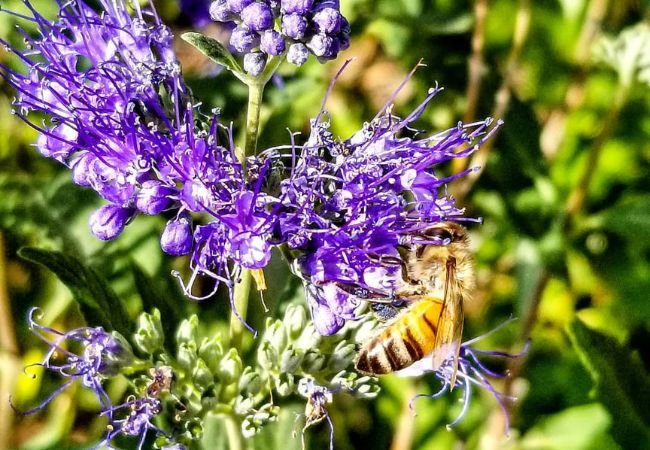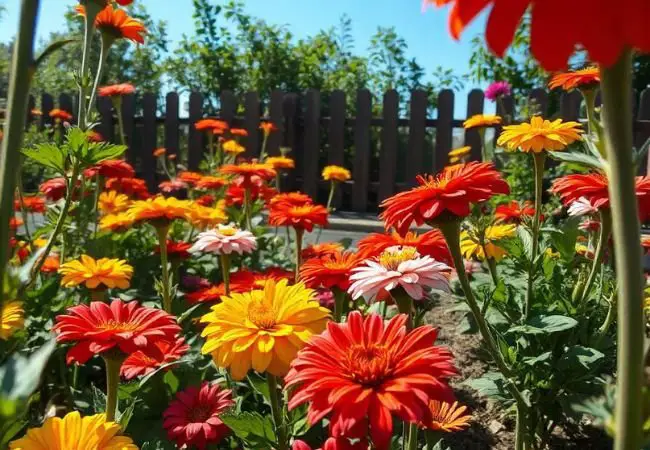Discover expert November garden tips to prepare for winter and ensure a vibrant spring. Learn about protecting plants, final harvests, soil prep, and more in our comprehensive 2024 guide.
As autumn winds down, November brings crucial gardening tasks to prepare for winter and set the stage for a vibrant spring. Focus on protecting tender plants, final harvests, soil preparation, and planting spring bulbs. Key activities include mulching, pruning, and winterizing your garden tools and irrigation systems.
Hey there, fellow garden enthusiasts! I’m Ashley, and I’ve been nurturing my garden through all four seasons for over two decades now. Let me walk you through some essential November garden tips I’ve picked up over the years. Trust me, your garden will thank you come springtime!
November Garden Tips: Essential Tasks for Late Fall
1. Protect Tender Plants
![November Garden Checklist: 7 Essential Tasks for a Thriving Spring [2024 Guide] 2 A cozy garden scene during early fall, showcasing various tender plants like young seedlings and flowering herbs. The foreground features delicate plants covered with lightweight fabric cloches or frost blankets, protecting them from the cooler temperatures. In the background, colorful autumn leaves gently fall from trees, creating a seasonal atmosphere. A gardener is seen carefully inspecting the protected plants, ensuring they are safe from the elements. Soft, golden sunlight filters through the trees, highlighting the vibrant greens of the tender plants. A small garden sign reads 'Protect Tender Plants,' emphasizing the importance of safeguarding them during the changing seasons.](https://usagardenhub.com/wp-content/uploads/2024/10/pikaso_text-to-image_Candid-image-photography-natural-textures-highly-r-12-1-701x1024.jpeg)
As the temperatures start to dip, it’s time to shield those delicate plants from frost damage.
Mulching for Winter Protection
One of the best defenses against cold weather is a good layer of mulch. Here’s how I do it:
- Apply a 2-3 inch layer of organic mulch around the base of plants
- Use materials like straw, leaves, or bark chips
- Keep mulch a few inches away from plant stems to prevent rot
Bring Potted Plants Indoors
Don’t forget about your container plants! I always bring mine inside when nighttime temperatures consistently drop below 45°F (7°C).
- Clean pots and inspect for pests before bringing indoors
- Gradually acclimate plants to indoor conditions
- Place in a bright location away from drafts
2. Final Harvests and Clean-up
![November Garden Checklist: 7 Essential Tasks for a Thriving Spring [2024 Guide] 3 A picturesque autumn garden scene depicting the final harvest of vegetables and flowers. In the foreground, a gardener is joyfully collecting the last ripe tomatoes, carrots, and squash, placing them into a woven basket. The garden beds show signs of a fruitful season, with some plants still bearing fruits while others are beginning to wilt. In the background, colorful fallen leaves blanket the soil, and a few spent plants are being carefully removed. Tools like a trowel and gloves rest nearby, indicating the clean-up process. Soft afternoon light bathes the scene, creating a warm and inviting atmosphere, while a small chalkboard sign in the garden reads 'Final Harvests and Clean-up,' capturing the essence of seasonal transition.](https://usagardenhub.com/wp-content/uploads/2024/10/pikaso_text-to-image_Candid-image-photography-natural-textures-highly-r-13-1-701x1024.jpeg)
November is often the last call for harvesting in many regions. Make the most of it!
Harvesting Late Season Crops
- Pick remaining vegetables like Brussels sprouts, kale, and winter squash
- Harvest any green tomatoes and ripen indoors
- Collect herb cuttings for drying or freezing
Garden Clean-up
A tidy garden is a healthy garden. Here’s what I focus on:
- Remove dead or diseased plant material
- Collect fallen leaves for composting
- Clean and store garden tools and equipment
3. Soil Preparation for Spring
![November Garden Checklist: 7 Essential Tasks for a Thriving Spring [2024 Guide] 4 A serene autumn garden scene illustrating the process of soil preparation for spring gardening. In the foreground, a gardener is collecting soil samples from different areas of the garden, using a small trowel and a bucket. Nearby, a soil testing kit and a guidebook are laid out, emphasizing the importance of testing soil health. In another section of the garden, a bed is filled with freshly sown cover crop seeds like winter rye, clover, and vetch, with the gardener lightly raking the soil. The background features vibrant fall foliage, indicating the changing season, while a small sign reads 'Soil Preparation for Spring,' capturing the proactive spirit of preparing for next year's garden. Soft, golden light bathes the scene, creating a warm and inviting atmosphere.](https://usagardenhub.com/wp-content/uploads/2024/10/pikaso_text-to-image_Candid-image-photography-natural-textures-highly-r-16-1-701x1024.jpeg)
Believe it or not, November is a great time to start thinking about next year’s garden.
Soil Testing and Amendments
I always recommend getting a soil test done in fall. It gives you plenty of time to make necessary adjustments.
- Collect soil samples from different areas of your garden
- Send for professional testing or use a home kit
- Add organic matter like compost or well-rotted manure based on test results
Cover Crops
Consider planting cover crops to improve soil health:
- Choose crops like winter rye, clover, or vetch
- Broadcast seeds and lightly rake into soil
- Come spring, turn the cover crop into the soil as green manure
4. Planting Spring Bulbs
![November Garden Checklist: 7 Essential Tasks for a Thriving Spring [2024 Guide] 5 A colorful autumn garden scene showcasing the process of planting spring-flowering bulbs. In the foreground, a gardener is kneeling beside a prepared planting bed, carefully placing healthy, firm bulbs such as tulips, daffodils, crocuses, and hyacinths into the soil. A small bag of bone meal or bulb fertilizer sits nearby, ready to be added to the planting holes. The bulbs are nestled in the rich, dark soil, and the gardener is using a trowel to cover them up. Surrounding the planting area are beautiful fall leaves in shades of red, orange, and yellow, hinting at the transition of seasons. A small chalkboard sign reads 'Planting Spring Bulbs,' highlighting the importance of this seasonal task. Soft, golden sunlight illuminates the scene, creating a warm and inviting atmosphere.](https://usagardenhub.com/wp-content/uploads/2024/10/pikaso_text-to-image_Candid-image-photography-natural-textures-highly-r-17-701x1024.jpeg)
November is prime time for planting spring-flowering bulbs in many regions.
Bulb Planting Tips
- Choose healthy, firm bulbs
- Plant at a depth of 2-3 times the bulb’s height
- Add bone meal or bulb fertilizer to the planting hole
- Water well after planting
Popular spring bulbs to plant in November:
- Tulips
- Daffodils
- Crocuses
- Hyacinths
5. Pruning and Tree Care
![November Garden Checklist: 7 Essential Tasks for a Thriving Spring [2024 Guide] 6 A tranquil late-fall garden scene illustrating the essential tasks of pruning and tree care. In the foreground, a gardener is carefully pruning a deciduous tree, removing dead and damaged branches with pruning shears. Nearby, a small pile of pruned branches indicates the work being done to improve air circulation and tree health. In another part of the garden, young trees are wrapped in protective burlap and secured with stakes, emphasizing the care taken to shield them from winter damage. Mulch is spread around the base of the trees, kept clear of the trunks. The background features colorful autumn foliage, and a small sign reads 'Pruning and Tree Care,' highlighting the importance of these seasonal tasks. Soft sunlight filters through the branches, creating a warm and serene atmosphere.](https://usagardenhub.com/wp-content/uploads/2024/10/pikaso_text-to-image_Candid-image-photography-natural-textures-highly-r-18-701x1024.jpeg)
Late fall is an excellent time for certain pruning tasks.
Pruning Deciduous Trees and Shrubs
- Remove dead, damaged, or diseased branches
- Thin out crowded growth to improve air circulation
- Avoid pruning spring-flowering shrubs, as you’ll remove next year’s blooms
Protect Young Trees
Shield young trees from winter damage:
- Wrap trunks with tree wrap or burlap
- Install stakes if needed to support against winter winds
- Apply mulch around the base, keeping it away from the trunk
6. Winterize Irrigation Systems
![November Garden Checklist: 7 Essential Tasks for a Thriving Spring [2024 Guide] 7 A practical winter scene in a backyard showcasing the steps to winterize irrigation systems. In the foreground, a gardener is turning off the water supply to an outdoor faucet, ensuring the system is properly shut down for winter. Nearby, hoses are being drained and coiled neatly, ready to be stored in a frost-free location, with a cozy shed in the background. A portable air compressor is positioned next to a sprinkler system, indicating the process of blowing out the lines, while a professional nearby offers assistance. The landscape is gently covered with a light dusting of snow, creating a winter atmosphere. A small sign reads 'Winterize Irrigation Systems,' emphasizing the importance of protecting plumbing from freezing temperatures. Soft, muted light enhances the scene's calm and practical feel.](https://usagardenhub.com/wp-content/uploads/2024/10/pikaso_text-to-image_Candid-image-photography-natural-textures-highly-r-19-701x1024.jpeg)
Don’t let frozen pipes catch you off guard!
Draining and Storing
- Turn off water supply to outdoor faucets
- Drain hoses and store in a frost-free location
- Blow out sprinkler systems or have them professionally winterized
7. Wildlife Care
![November Garden Checklist: 7 Essential Tasks for a Thriving Spring [2024 Guide] 8 A charming winter garden scene focused on caring for wildlife during the colder months. In the foreground, a colorful bird feeder filled with sunflower seeds and suet is attracting various birds, which are perched nearby. A small heated water source is visible, ensuring that the birds have access to fresh water, even in the cold. The garden is intentionally left a bit 'messy,' with areas of native grasses and wildflowers providing natural shelter for wildlife. In one corner, a beautifully crafted bee hotel is set up, inviting solitary bees for winter refuge. Brush piles made from twigs and branches offer cozy spots for small animals. A small sign reads 'Wildlife Care,' highlighting the importance of supporting garden friends during winter. Soft snow gently blankets the ground, and a serene light enhances the tranquil atmosphere.](https://usagardenhub.com/wp-content/uploads/2024/10/pikaso_text-to-image_Candid-image-photography-natural-textures-highly-r-20-701x1024.jpeg)
Remember our garden friends during the cold months.
Feeding Birds
- Set up bird feeders with high-energy foods like sunflower seeds and suet
- Provide a source of fresh water, using a heater if necessary
- Clean feeders regularly to prevent disease spread
Creating Wildlife Habitats
- Leave some areas of your garden “messy” for wildlife shelter
- Consider building or purchasing a bee hotel for solitary bees
- Create brush piles for small animals to use as winter refuge
November might seem like the end of the gardening season, but it’s really about setting the stage for next year’s success. By following these tips, you’ll not only protect your garden through winter but also give it a head start for spring. Remember, every garden is unique, so feel free to adapt these suggestions to your specific climate and needs.
Happy gardening, and here’s to a beautiful spring ahead!
For more gardening tips and plant care guides, visit usagardenhub.com.

![November Garden Checklist: 7 Essential Tasks for a Thriving Spring [2024 Guide] 1 November Garden Checklist: 7 Essential Tasks for a Thriving Spring [2024 Guide]](https://usagardenhub.com/wp-content/uploads/2024/10/a-visually-engaging-infographic-style-image-displa-aDjwzgQ5TEK7UTXQPjcVDg-RSeeSRSzQxm2uX-VrKIl1Q.jpeg)





One comment on “November Garden Checklist: 7 Essential Tasks for a Thriving Spring [2024 Guide]”